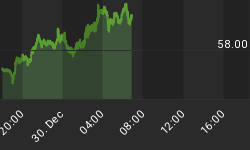After 2012 ended with more than the usual amount of whimpering (although not from investors, who saw gains in equity as well as bond markets), 2013 has begun with a bang.
The fiscal cliff has become more of a fiscal slope, with tax increases on high-earners in the form of higher marginal rates, and on all other earners in the form of the expiration of withholding tax cuts. (Hence, the 'middle class' that was supposedly protected in this deal is apparently defined as the jobless.) The spending cuts were delayed for two months, so that the impact of these tax increases - as well as tax increases associated with the implementation of Obamacare - is the only part of the "fiscal cliff" that will be immediately felt.
However, in two months there will be another showdown over spending and the debt ceiling, with more uncertainty for investors and consumers.
Now, it may be that this works out to be clever. If the economy continues to gain strength, then it will be easier to cut spending in two months than it is now. And, if the economy is really booming as much as some say, the budget cutting should be aggressive (since, after all, if we can't balance the budget during boom times, when can it be balanced?). Color me skeptical on this point, although as I said in my wrap-up comment last year I think 2013 will be a better year in terms of growth than 2012 was.
It is certainly beginning that way; or, rather, I suppose 2012 ended with some momentum. The December ADP figures showed a 215k increase in payroll jobs, and an upward revision to November's data. The 215k number was above expectations, and the highest figure since the spring. Be a bit cautious in extrapolating that surprise to tomorrow, however, as the data suggest there has been insufficient seasonal adjustment in December for the last few years. (December usually sees lots of hiring, and January lots of firing; by adjusting for this tendency we should eliminate this tendency from the data. However, the absolute scale of the hirings/firings at this time of year is so large that seasonal adjustment is very difficult. The BLS tends to be more successful at it than ADP, so all else being equal I would be wary of the possibility that tomorrow's Payrolls data (Consensus: 153k) falls short of the newly-raised expectations...the consensus of the 15 economists on Bloomberg who updated their forecasts today after ADP is 180k, rather than 153k.
Nevertheless, the economy is indeed expanding. I would even say that it is expanding faster than I would have hoped a couple of months ago. (That isn't to say that the current pace is torrid, but rather that I am a congenital sourpuss, a consequence of being a bond guy who wants my money back rather than an equity guy who dreams of sugarplums).
The rotten part, from investors' perspective, is that the stock market and the corporate bond market have already priced in great growth results, and bond markets haven't yet. That's how you get both bonds and stocks doing well in 2012, after all.
The question for buyers of the equity market is, how much better can companies do? The chart below (Source: Federal Reserve Z.1) shows that as of Q3, after-tax corporate profits stood at a post-war record of 12.6%. This was actually an increase over levels that were already lofty.

To be sure, this ratio can fall without corporate profits themselves declining - if, going forward, national income expands at a rate faster than profits, then this ratio will decline. Question: do you think that the market would react well to earnings growth of 1% when the economy is growing at, say, 3%? Me either.
On the fixed-income side of the ledger, interest rates have done some important technical work recently. Ten-year nominal bond yields have risen 30bps in the last month, and the 1.91% rate on 10-year Treasuries is the highest since May. Even more interesting is the fact that this movement in nominal rates has come completely from a rise in real yields (recall that nominal yields equal, approximately, the sum of real yields and a priori inflation expectations), which have also risen 30bps over the last month. Ten-year real yields (TIPS) are now the highest they have been since August, at -0.61%. Moreover, this is the first time that 10-year real yields have risen at least 30bps from a prior yield low since October 2011 (see chart, source Bloomberg).

The fact that inflation breakeven expectations, while near the highs of the last few years, have not risen further in this fixed-income selloff suggests that the selloff is being driven more by growth expectations (which most directly impact real yields) than by inflation fears. That seems consistent with the anecdotal chatter. It seems that investors, for now, are comfortable with long-term breakeven inflation around 2.5% and inflation swaps (a purer measure of inflation expectations) around 2.75% at the 10-year point. There are sellers there, for now. The discontinuity will likely be abrupt, when it happens, but at the current rates TIPS have plenty of room to weaken further and provide the majority of the nominal-yield increase.
I still think there will be an abrupt discontinuity, although the Fed continues to be very confident (as the FOMC minutes released today showed) that inflation expectations are "well-anchored." They are until they aren't, I guess. For their sake, I hope the anchor drags along, rather than simply snapping off.
















